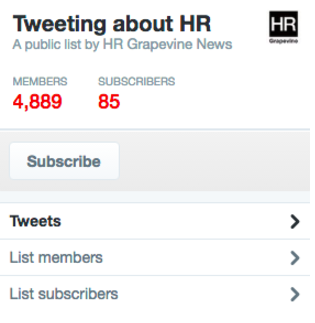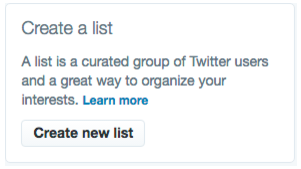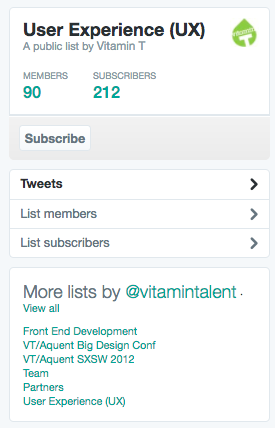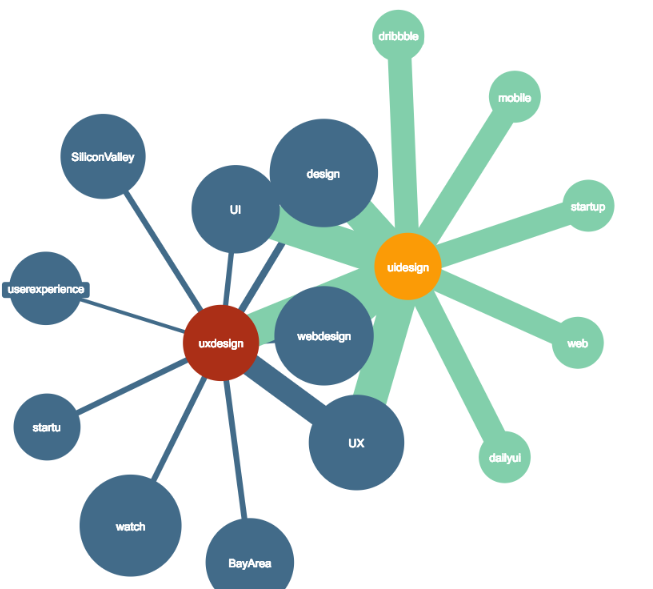Sourcing on Twitter: Advanced search strategies for recruiting
Sourcing passive candidates means being where they are, and many are on Twitter. (About 313 million each month). But with thousands of tweets posted every second, it can be difficult to narrow your search.

Here is how to find candidates on Twitter using advanced recruiting and sourcing:
1. Make a Twitter list
Twitter lists are groups of Twitter accounts you can curate to help organize your feed. When you view a list, you’ll only see tweets from its members. For example, if you want to read tweets exclusively from your company’s HR team, search on Twitter and make a list with the accounts of all employees working at your HR department.
Below is a list about HR-related topics created by HR Grapevine News. You can follow this list by subscribing and reading tweets from all its members.

Here’s how to create a sourcing list on Twitter:
Click on your avatar on the top right of your page and choose the “Lists” option. You’ll see all lists you’re already a member of and a prompt to create a new one.

Name your new list, add a description and choose to make it private (only accessible by you) or public (anyone can subscribe to the list.) Opt for private if you want to follow people without notifying them. To add a person or company to your list, go to their profile, click on the settings symbol (the gear next to the Follow/Following button) and choose “Add or remove from lists.” Pick the list you want to add them to and you’re done.

Here’s how to use Twitter lists to improve your sourcing:
- Create private Twitter lists to recruit passive candidates. This will save you valuable time when you want to contact candidates, as you’ll have their profiles organized in one place. If you spot something interesting among someone’s tweets, you could send them a message. Such lists could also serve as talent pipelines. Consider adding past candidates who you almost hired. If you want to consider them for a future role, it’s best to keep up with their activity.
For EU candidates specifically, please refer to guidance on using social media for recruiting and collecting candidate information as per the General Data Protection Regulation, or GDPR.
- Craft public Twitter lists to stir up recruitment interest. Public Twitter lists could be a smart way to attract passive candidates and increase your response rate to cold emails. Create a list using an interesting name, like “The Ruby-on-Rails Incredibles” and add people who’d make great candidates for similar roles. Once they see you’ve added them to that list, you’ll have their attention. Including them in your list could also increase your chances of getting a response, if you decide to contact them.
- Group candidates in event guest lists. Twitter lists can help you promote events you host by allowing you to curate a guest list and keep in touch. They can also help you keep track of the attendees of industry events (regardless of whether you attend those events or not).You can find potential candidates without meeting them in person if they tweet about an event or conference in an industry you’re recruiting for. Tools like IFTTT and simplify360 can automate your list-building by adding people to lists based on what you’re looking for. For example, while sourcing a marketing operations hire in Boston, it’d be a good idea to add Boston-based attendees of #Mrktgnation or #Dreamforce to your sourcing list.
2. Advance your recruiting search
Instead of using a simple sourcing search, consider Twitter advanced search feature. It allows you to find candidates on Twitter by multiple criteria like location, keywords, languages and hashtags. To grow your network of passive candidates, you could also look for people who mention other users. Even if someone you approach isn’t currently interested in your job opportunity, they might be connected to someone who is.
You can filter your search results by accounts, tweets, videos, photos and news. Twitter advanced search is also helpful when you want to track specific tweets from a passive candidate and use them to craft a personalized message about your job opportunity.

3. Use Boolean search for better sourcing
An alternative to Twitter’s advanced search is using Google to find candidates. Boolean search strings help you scan Twitter to identify professionals with your desired criteria. For example, a simple search for mobile developers in Boston with experience in Swift, could look like this:

Boolean search can also help you find public lists that gather professionals from a specific industry who usually tweet about related topics. For example, here’s a boolean string you could use to search for lists of interesting UX designers:

This sourcing search returns public lists, like “UX Design” “User Experience (UX)” and “awesome UX/Design people.” You can subscribe to these lists, follow their discussions and explore other lists curated by the same account.

Workable’s Boolean search cheat sheets provide sample search strings to recruit experienced candidates.
4. Use the right hashtags
Hashtags help you find the right candidate. Think of hashtags like targeted keywords that help broadcast your job posts to relevant Twitter users. Make your hashtags as skill-specific as possible: for example, #sales and #London are more effective than #jobs and #hiring.
Maximize your hashtags by choosing the most popular and relevant ones. Online tools like Hashtags.org provide metrics and tracking systems for your hashtags. There are also free hashtag generators, like all-hashtag.com and hashtaggenerator.com. Hashtagify.me can also help you find, and visualize, relevant topic hashtags based on trends and analytics:

- Via Hahtagify.me
Want more detailed information on various sourcing methods? Download our free sourcing guide.
5. Build before you need
Don’t wait until a job becomes vacant. While recruiting on Twitter won’t replace your traditional hiring methods, it’s a great tool to get in touch with potential candidates. Start building relationships with them today.
Glen Cathey, a talent acquisition consultant and keynote speaker, explains how Twitter discussions can benefit your recruiting endeavors:
“Engaging people on Twitter is really no different that striking up a conversation in person. You hear someone talking about the game last night, a book they read, a work challenge, etc., and you can easily jump right in with relevant content and/or questions…engaging people in two-way conversations is social.”
Keep talking to promising people, comment on their tweets and share relevant updates. Effective social media sourcing isn’t about finding and closing candidates quickly. It’s a long-term employer brand building exercise.




